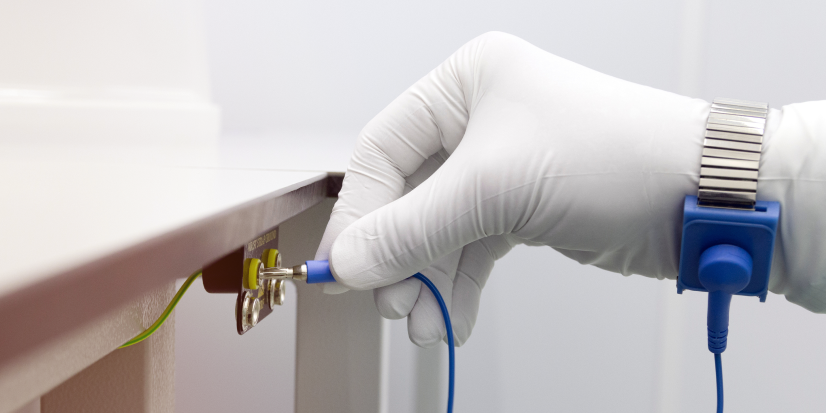Every engineer has felt it at least once. You walk across the office, reach for the door handle, and a sharp spark snaps at your fingertip. Annoying, but harmless—or so it seems. Now imagine the same spark, invisible to the naked eye, striking a microchip with features smaller than a virus. That single discharge can destroy months of engineering work or stop an entire production line. This is the hidden world of electrostatic discharge (ESD).
What is ESD and how does it occur?
Definition of electrostatic discharge (ESD)
Electrostatic discharge is the sudden transfer of electricity between two objects with different electrical charges. At its core, it is nothing more than the movement of electrons seeking balance. Yet, in high-tech environments, this short-lived spark can be catastrophic.


How electrostatic charge builds up
Static electricity builds silently. Friction between materials, separation of two connected surfaces, or even induction from a nearby charged object can all trigger it. Walking across a carpet can generate thousands of volts on a human body. The air feels normal, nothing alerts you—but when your finger touches a conductive surface, the stored energy discharges in an instant. In electronics manufacturing, even 20 volts may be enough to permanently damage a component, far below the threshold a human can feel.
Real-World and industrial examples of ESD
The effects of ESD scale dramatically. At home, it’s the tiny sting when touching a car door. In industry, it’s the spark that can ignite fuel vapors in a refinery or coal dust in a mine. In electronics, it’s the invisible discharge that leaves a microchip weakened, ready to fail months later. At the extreme end of the spectrum stands lightning—nature’s largest electrostatic discharge, measured in millions of volts.
Why is ESD dangerous for electronics?
Visible and hidden damage
When ESD strikes a semiconductor, two outcomes are possible. In catastrophic failure, a transistor junction or oxide layer burns out instantly, leaving the device useless. In latent damage, the chip continues to work but with weakened structures. This hidden failure mode is far more dangerous—the component may pass factory testing but fail unexpectedly in the customer’s hands, damaging trust as well as hardware.
Sensitivity of modern electronic components
As electronics shrink, vulnerability increases. Today’s chips, built at nanometer scales, rely on ultra-thin insulating layers. What could withstand hundreds of volts two decades ago can now be destroyed by just a few dozen. In practice, a charge too small to feel—50 volts—can silently ruin a state-of-the-art microcontroller.
ESD as a source of electromagnetic interference (EMI)
The risk doesn’t end with component failure. Each discharge emits broadband electromagnetic noise, strong enough to disrupt communication, reset logic circuits, or interfere with sensitive medical and aerospace equipment. In industries where reliability is measured in lives, ESD is more than a quality issue—it’s a safety hazard.
How to protect against ESD
Workstation protection—mats, grounding, ionizers
The frontline defense is the ESD-protected area (EPA). Here, every surface, tool, and operator is controlled. Antistatic mats and flooring bleed charges to ground. Wrist straps and heel straps keep workers at the same potential as the equipment. Ionizers release balanced streams of positive and negative ions, neutralizing charges on insulators that cannot be grounded. Together, these measures turn a high-risk environment into a safe zone for sensitive devices.
Best practices when working with electronics
Technology alone is not enough. The behavior of people is equally the most important. Engineers must ground themselves before handling components, store parts in conductive packaging, and control humidity to prevent charge build-up. Training and awareness ensure that ESD safety becomes second nature rather than an afterthought.’
Built-in circuit protection in electronic devices
Fortunately, modern electronics are not defenseless. Designers integrate ESD diodes, TVS arrays, resistors, and ferrite beads directly into circuits. These act as safety valves, shunting dangerous surges away from vulnerable nodes. However, these protections are not limitless—they are designed for unexpected events, not repeated negligence. Workplace controls remain essential.
Summary
Electrostatic discharge is invisible, unpredictable, and relentless. Yet, with the right practices and technologies, it can be tamed. Every unprotected workstation is a risk, every ungrounded operator a potential spark.
If you want to ensure that your production, products, and reputation remain safe from this hidden threat, our experts can help. Contact our engineers today to design a tailored ESD protection strategy for your operations.
DISCOVER OUR
Whitepaper
Achieve the perfect user-display interaction with the right Touch Sensor IC. Ever faced issues with phantom touch events or certification? Boost your R&D like a pro with our Whitepaper!




